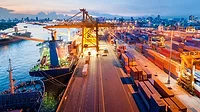Building Strong Links in Supply Chain Security
How can video management systems help strengthen the links in your enterprise’s supply chain?
The supply chain is a long and complex one. And one that needs protection along the way.
At BJ’s Wholesale Club, there is everything from pallets of goods to choice steaks along the chain. At Port Freeport in Texas, the chain extends from Brazil, China, Colombia, Costa Rica, Mexico, Venezuela and many more, with well over 13,000 people handling cargo off ships. Thousands of miles from the Lone Star state, in Melbourne, Australia, Coode Island is one of Victoria’s major bulk liquid storage facilities. Supplying more than 400,000 tons of hazardous and non-hazardous chemicals yearly, Terminals Pty. Ltd. receives liquid products by pipeline from ships, and stores them in the approximately 70 tanks throughout the premises.
Enterprise security leaders at these operations as well as elsewhere now employ security video, often integrated with other security and business systems, to ensure the safety and security of the chain.
Retail Chain Challenge
BJ’s Wholesale Club introduced the warehouse club concept to New England in 1984. Since then, the chain has grown to become one of the top three leading warehouse chains in the United States. Headquartered in Natick, Mass., the company operates more than 190 clubs in 15 states with 102 gas stations and three main distribution centers.
In a store environment as large as BJ’s Wholesale Club, response time to potential incidents is paramount. Locations in the past employed an older video system comprised of PC-based DVRs and analog cameras to monitor its stores. Maintenance and upkeep was needed often and the system just wasn’t scalable. The DVRs maxed out quickly and the length of storage was limited.
There was also a safety issue.
At BJ’s Wholesale Club, large equipment, such as forklifts, is frequently used to transport goods for restocking and products are commonly stored on large pallets. The combination of a large space, frequent goods restocking and large machinery can lead to accidents, but the chain is committed to minimizing the possibility of incidents before they can occur.
So the enterprise moved to an IP solution to leverage existing network infrastructure. And there were other needs, too: technology that integrates video systems with other applications and provides remote monitoring capabilities.
The solution is an enterprise IP video surveillance solution that provides seamless management of digital video, audio and data across an IP network. In addition, integrated point of sale searching identifies suspicious register transactions including voids, refunds, markdowns, as well as employee and gift card sales.
The bottom line is that the company can manage shrinkage, increase safety and reduce losses and make operations more efficient.
Cargo from World Points
There were different challenges along the supply chain at Port Freeport, which goes back 100 years when the first jetty system was built in Freeport, Texas. Since that time, the port has become one of the fastest growing on the Gulf Coast.
Port Freeport uses video surveillance technology to ensure the safety of its employees as well as to ensure the smooth execution of daily operations. More so, as one of the fastest growing ports on the Gulf Coast, Port Freeport is in constant surveillance of incoming threats from the water perimeter.
When millions of dollars of cargo are at stake and a country’s water perimeter is susceptible to potential dangers via both land and sea, Rick Benavidez, the port’s director of safety and security, says that “we were looking for a more advanced IP-based system that would allow the integration with our vessel-radar system, and also offer us the possibility to grow the system as we move forward.” Ideally, Port Freeport wanted a new system that would allow them to automate the camera prompt when a vessel was detected in their security zone via the radar system. Its main objective was to leverage both technologies’ strengths as well as to facilitate and streamline the decision-making process for all operators at the port.
Now “we get an AIS [alarm indication signal], a camera view, and we can determine right away whether or not it is a coastguard, pilot, people that are authorized to enter or not,” adds Benavidez. “If it’s a shrimp boat, we need to get out there and take action. Now, we can respond to situations more quickly and effectively, especially on the waterside.”
To add to their enhanced waterside security, some new wirelessly-connected cameras were installed on radar towers a couple miles out from the port, where incoming vessels into the Federal Channel could be tracked. With no direct connectivity due to distance and topography, the cameras were installed with point-to-point wireless encoders and receivers.
Radar Integration
Finally, with the vessel-radar system in place, Port Freeport has plans to continue pushing the bar in terms of technological advancements for security at the port. For added security and underwater monitoring, it is looking to incorporate sonar technology into the entire solution.
For Terminals Pty. Ltd., the supply chain challenge needed to ensure that the highest level of security was maintained for the safety of all employees and nearby residents. The bulk chemical storage company insisted on having the premises manned with security personnel 24 hours a day and hired security staff to stand guard on the facility grounds and to monitor the alarms that were automated in case of fire, intrusion, plant or process malfunctions by local systems. In the event that an alarm did go off, security officers would react as required, alerting Terminals management, who would take the appropriate action. Although it ensured that action would be taken immediately, such a vague and old fashioned process was costly since officers were being paid around the clock; not to mention it also opened the door to human error.
Additionally, through the use of a standard access control system, Terminals facility operators monitor movement through the site by those with access to the perimeter such as staff, contractors and visitors. Although this solution was put in place to secure the premises, the system itself was as basic as the manned surveillance solution that they utilized. This localized system did not have high-end administrative capabilities, which could provide authorities with consolidated security information from the various systems and alarm processes in place. With users having to manage many different system functions independently, operational efficiency was not being maximized.
So more than an electronic solution, Terminals was in need of a system that would allow security operators to effectively manage the many different independent systems that were currently deployed on site. The solution: reacting to breaches throughout the premises through microphonic detection, 16 pan-tilt-zoom cameras were installed, which are controlled by the system’s event/alarm management feature.
There are also remote access capabilities since now the system is completely being monitored through a remote central station. In the evenings, when there are no security officers on site, the security system continues to automatically manage critical information, alerting the central station of any malfunction or breach in security. From there, remote agents can recognize alarms, pull-up live video stream and dispatch patrols to respond to events.
Homeshoring Back on Top?
Are things coming back home? The Council of Supply Chain Management Professionals’ (CSCMP) Research Strategies Committee (RSC) thinks so. It recently initiated a research project to approach and report on the offshoring-to-reshoring movement.
The literature suggested that many companies initially did a poor job with their offshoring initiatives, because many skipped an exhaustive review and consideration of total costs and supply chain effects. Such moves sometimes led to customer service and market response problems or did not lower costs as expected. Over time, companies have shifted to more sophisticated total cost approaches. As a consequence, with labor costs rising in some developing economies, increases in logistics costs driven by higher fuel costs and changes in customer expectations, there has been a reported shift to nearshoring and even a return to homeshoring. Others, though, report that offshoring remains strong, but with an increasing emphasis on other considerations – particularly market development and access to global talent.
However, the actual trends are not clear, nor are the relative shifts in balance among sourcing location choice drivers. What is also not reported is how to take long-term considerations of factor cost trends into account when making location decisions. Given that much of the reporting is anecdotal, the CSCMP RSC felt there could be significant value in systematic research to better understand location decision trends and the key factors driving them.
Pharma and the Supply Chain
The U.S. Food and Drug Administration continues to investigate a growing number of cases involving counterfeit prescription drugs – cases that threaten the health of individual patients and the safety of the nation’s drug supply. Federal officials document that American consumers have purchased counterfeit Adderall, Vicodin, Xanax, flu medications and even cancer drugs. State legislators are working to tackle the problem with laws and regulations to secure prescription drugs from the manufacturer to a home medicine cabinet.
According to pharmaceutical supply chain managers and security executives, a contradictory patchwork of state rules encourages criminals to enter markets with the lowest safety requirements to inject counterfeit, unsafe and potentially lethal products into the national supply chain.
Looking for a reprint of this article?
From high-res PDFs to custom plaques, order your copy today!







